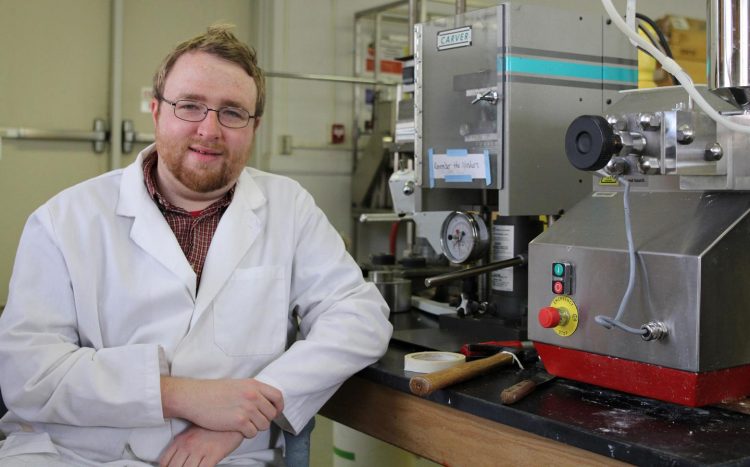Recipe for antibacterial plastic: Plastic plus egg whites

Alex Jones, a doctoral student in the department of textiles, merchandising and interiors at the University of Georgia, is studying the antibacterial properties of bioplastics. He's found that albumin, a protein found in egg whites, looks the most promising. Credit: Cal Powell/UGA
Bioplastics made from protein sources such as albumin and whey have shown significant antibacterial properties, findings that could eventually lead to their use in plastics used in medical applications such as wound healing dressings, sutures, catheter tubes and drug delivery, according to a recent study by the University of Georgia College of Family and Consumer Sciences.
The bioplastic materials could also be used for food packaging.
Researchers tested three nontraditional bioplastic materials–albumin, whey and soy proteins–as alternatives to conventional petroleum-based plastics that pose risks of contamination.
In particular, albumin, a protein found in egg whites, demonstrated tremendous antibacterial properties when blended with a traditional plasticizer such as glycerol.
“It was found that it had complete inhibition, as in no bacteria would grow on the plastic once applied,” said Alex Jones, a doctoral student in the department of textiles, merchandising and interiors. “The bacteria wouldn't be able to live on it.”
The study appears in the online version of the Journal of Applied Polymer Science.
One of the researchers' aims is to find ways to reduce the amount of petroleum used in traditional plastic production; another is to find a fully biodegradable bioplastic.
The albumin-glycerol blended bioplastic met both standards, Jones said.
“If you put it in a landfill, this being pure protein, it will break down,” he said. “If you put it in soil for a month–at most two months–these plastics will disappear.”
The next step in the research involves a deeper analysis of the albumin-based bioplastic's potential for use in the biomedical and food packaging fields.
As noted in the study, 4.5 hospital admissions out of every 100 in the U.S. in 2002 resulted in a hospital-acquired infection. In addition to the risk of contamination in hospitals, food contamination as a result of traditional plastics is a notable risk.
Researchers are encouraged by the antimicrobial properties of albumin-based bioplastics that could potentially reduce these risks through drug elution–loading the bioplastic with either drugs or food preservatives that can kill bacteria or prevent it from spreading.
###
Study co-authors are Suraj Sharma in the department of textiles, merchandising and interiors and Abhyuday Mandal in the department of statistics, who aided in the statistical analysis and discussion.
The study, “Protein-based bioplastics and their antibacterial potential,” is available online at http://onlinelibrary.
Media Contact
All latest news from the category: Materials Sciences
Materials management deals with the research, development, manufacturing and processing of raw and industrial materials. Key aspects here are biological and medical issues, which play an increasingly important role in this field.
innovations-report offers in-depth articles related to the development and application of materials and the structure and properties of new materials.
Newest articles

Superradiant atoms could push the boundaries of how precisely time can be measured
Superradiant atoms can help us measure time more precisely than ever. In a new study, researchers from the University of Copenhagen present a new method for measuring the time interval,…

Ion thermoelectric conversion devices for near room temperature
The electrode sheet of the thermoelectric device consists of ionic hydrogel, which is sandwiched between the electrodes to form, and the Prussian blue on the electrode undergoes a redox reaction…

Zap Energy achieves 37-million-degree temperatures in a compact device
New publication reports record electron temperatures for a small-scale, sheared-flow-stabilized Z-pinch fusion device. In the nine decades since humans first produced fusion reactions, only a few fusion technologies have demonstrated…





















